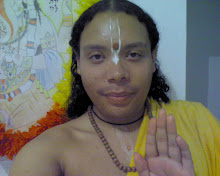


Bhaktivedanta Narayana Goswami was born in the village of Tewaripur, near the bank of the Ganges river in Bihar, India on the Amavasya (new moon) day of February 16, 1921.
Throughout his childhood Narayana Goswami would frequently accompany his father to kirtana and pravachan assemblies. When he met Śrī Narottamananda Brahmacari, a disciple of Bhaktisiddhanta Sarasvati Thakura who was travelling and preaching the message of Chaitanya in that area, he soon became convinced of the paramount position of the philosophy given by the acharyas in the line of Rupa Gosvami. In February 1947, Narayana Goswami made the journey from his home village to Navadvipa, West Bengal to meet with his guru for the first time. Within days he left home to join the mission of his spiritual master and surrender his life.
When he arrived in Navadvipa, the annual parikrama was under way and he joined the group. Upon its completion on Gaura-purnima, he was awarded both harinama and gayatri initiations by Bhakti Prajnana Kesava Goswami and received the name Śrī Gaura Narayana. Over the next five years, Narayana Goswami travelled extensively with Bhakti Prajnana Kesava Goswami on preaching tours throughout India, and, in 1952, on Gaura-purnima, Bhakti Prajnana Kesava Goswami awarded him initiation into the sacred order of sannyasa.
In 1954 Bhakti Prajnana Kesava Goswami posted him in charge of his new Radha-Krishna temple in Mathura named Kesavaji Gaudiya Matha. Narayana Goswami would spend part of the year in Mathura and the other part in Bengal. In this way, he continued extensive services in both places for the next fourteen years. Bhakti Prajnana Kesava Goswami appointed him as Vice-President of his institution, the Gaudiya Vedanta Samiti, and Editor-in-Chief of its Hindi publications and the monthly magazine Śrī Bhagavat Patrika. When Bhakti Prajnana Kesava Goswami passed from this world in 1968, Narayana Goswami performed all the necessary ceremonial rituals for his samadhi burial.
During this period Narayana Goswami also began to organize the annual Karttika Vraja Mandala Parikrama which he continues to the present day.
Narayan Goswami was requested by Bhakti Prajnana Kesava Goswami to translate the books of Bhaktivinoda Thakura from Bengali into his native language, Hindi. He has carried out this request by translating some of the Thakura's most prominent books, such as Jaiva Dharma, Caitanya-siksamrta, Bhakti-tattva-viveka, and Vaisnava-siddhanta-mala
